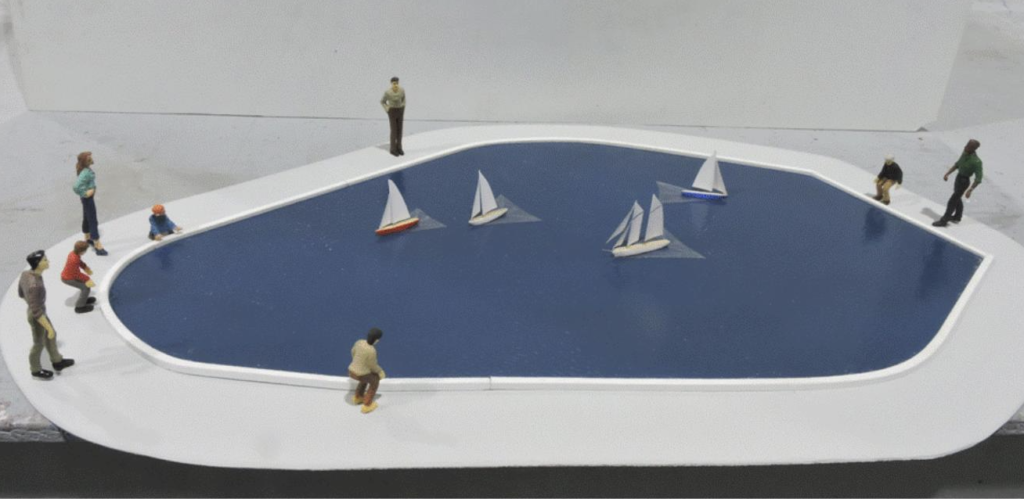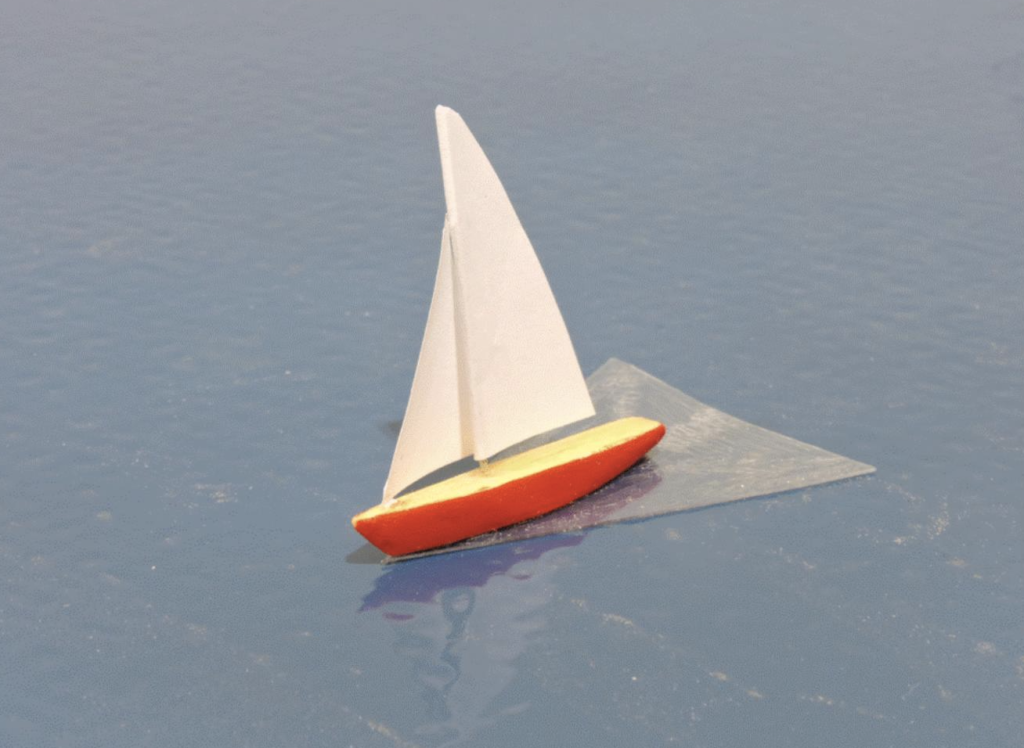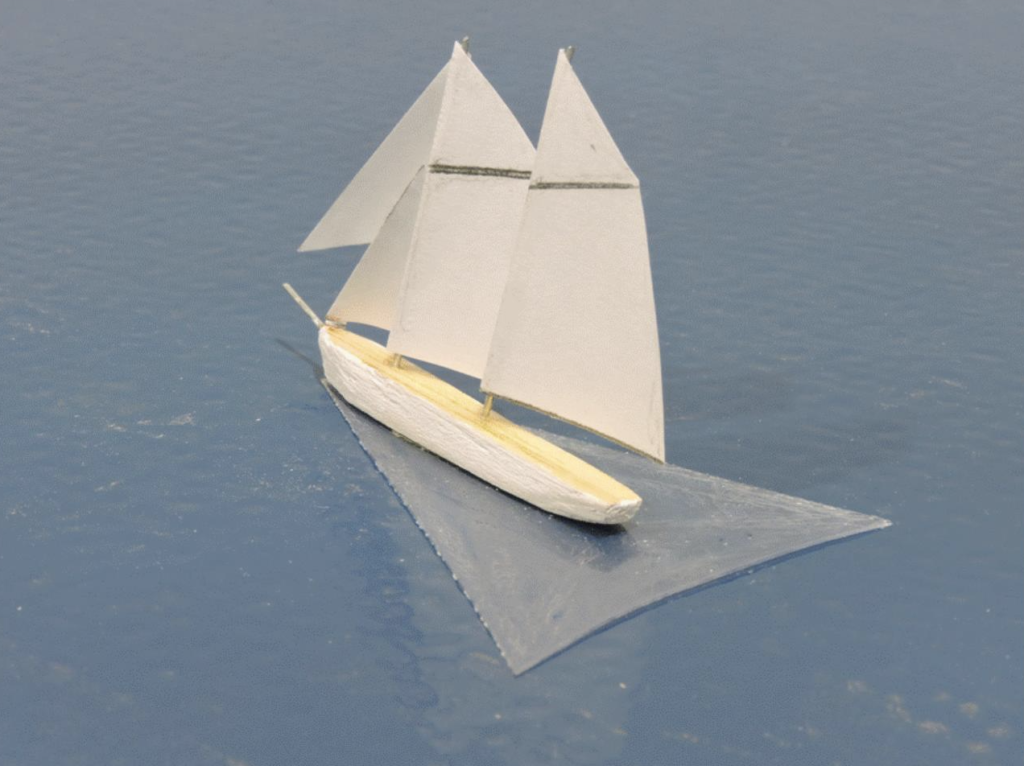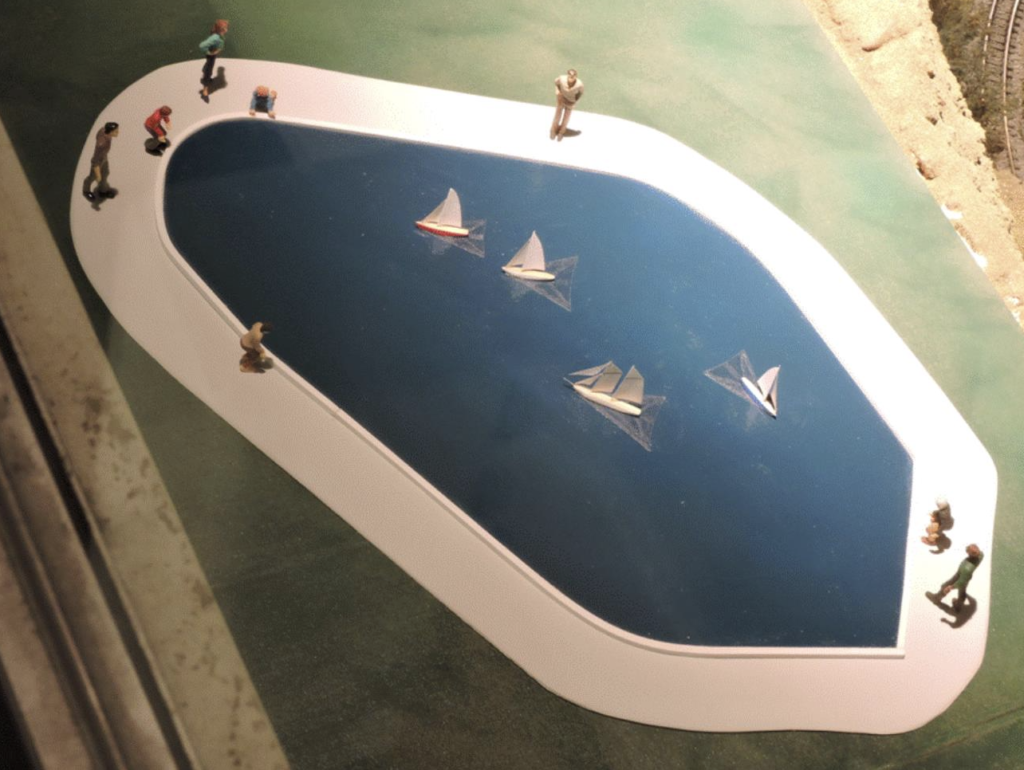#159 December Status Report
December 4, 2020
The Big Train Project Status Report (Part 159)
This month’s report describes a scenic element that was recently applied to the vacant area on the shelf on the EnterTRAINment Junction (EJ) mezzanine wall. This shelf is the destination of the Aerial Tramway and the location of the Cliffside Restaurant, which were the subjects of previous editions of this report.
While discussing the potential scenic elements that could fill the empty space on the mezzanine shelf, it was mentioned that it would be interesting to have a lake overlooking the Middle City, similar to the lake in Cincinnati’s Eden Park, which overlooks the Ohio River. As an avid model yachtsman since 1962, I was intrigued by this idea. The available area was not very large, but could be big enough for a model boat pond, with, of course, model boats to add to the potential interest. Since the shelf area décor was still in flux, we decided to build the lake as a movable topper on the existing temporary scenery, with the potential to transplant it when the permanent scenery is produced. Figure 1 shows the upper tram station and, in the foreground, the rectangular temporary green-painted cardboard overlay used to cover the bare wooden shelf.

Having a piece of clear plastic from a fluorescent light fixture with a faceted surface on one side and a gently waved surface on the other, we decided to use the wavy side, painted dark gloss blue, to make a believable surface of the lake. The size and shape of the piece dictated the size and shape of the lake, with mixture of round and straight edges to miss some of the “imperfections” in the piece. The plastic was cut along a number of straight lines using the score-and-break method and then rounded, where desired, using a belt sander to get to the finished contour. The plastic sheet was then mounted to a larger similarly shaped piece of Masonite®, the edges of which were tapered to simulate a gravel path around the lake’s periphery. It was painted light gray to simulate crushed granite. Some white plastic rectangular-cross-section edging was bent to the shape of the lake’s shore with the help of a heat gun and glued to the Masonite® base at the lake’s edge. With the lake complete, it needed a few embellishments – model boats and some “sailors,” both children and adult (Figure 2).

Since this scene is in the Middle Period (late 1940s to early 1950s) the model boats would most likely be free-sailing rather than radio controlled. Even though the first radio-controlled sailboat dates back to the late 1930s, radio control for sailboats didn’t really become common until the 1960s. The size of the lake limits the size of the boats that would realistically be sailing on it without looking ridiculously large. We chose to model two-foot long (one-inch) and three-foot long (1½-inch) sailboats, all on the move. One of the challenges of showing moving boats in a model is modeling with the wake (disturbed water) that the boats should be leaving behind them. Since this lake would only be viewable from above (from the EJ mezzanine window), the triangular wake could be simulated by an etched piece of transparent plastic packaging material. Figure 3 shows one of the three sloops (single mast, two sails) with its wake. Note that the flatter-than-normal angle of view allows reflections to unrealistically change the color of both the lake and the wake. When viewed from above, as in Figure 2, the colors are more realistic.

The boat hulls are carved wood, some basswood, some balsa; the masts are steel wire; and the sails are paper. Since these models will usually be viewed from at least four feet away, they didn’t require a lot of detail to still be effective (Figures 3 and 4).

The models in Figure 5 are shown leaning (“healing”) away from the EJ viewer as they would be on the layout. This provides a better profile to look at, but that’s not the real reason for the heal. In order for this lake to be useful for model sailing, it needs to have a reasonably consistent and predictable wind direction over its length. If the wind were coming from the cliff side, the wind would be shooting upward at the cliff edge and forming a very turbulent rolling burble over the lake that would be very bad for model sailing. Instead, the wind needs to come from the direction of the mezzanine wall (which in the model world is not there), blowing away from EJ guest observers (which don’t exist in the model world either). The model also displays one of the normal human foibles common for guys and their toys: if it moves it can be raced, as it appears the red and white sloops are doing at the left of Figure 5.

Since sailboats cannot sail directly upwind, three of modeled boats are show sailing at an angle to the imaginary wind direction coming from the imaginary non-existent mezzanine wall. The location of the wall is under the window track shown at the left in Figure 6.

So, we return to the view in Figure 1, but now with Larry’s Lake in place (Figure 7).

As you may have noticed, we modelers can’t leave a vacant space unadorned, and so it is with the mezzanine shelf, where the green cardboard cover will eventually give way to a pleasant park with its model boating lake.
© 2020 Tom Bartsch
MVGRS Big Train Project Coordinator

 Tickets
Tickets Parties
Parties Shop
Shop Directions
Directions